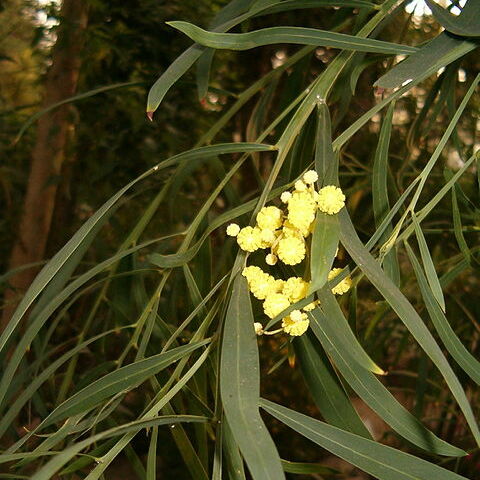Dense shrub or tree to 6 m high, often clonal. Bark dark grey and fissured on main trunks. Branchlets glabrous, scurfy. Phyllodes linear to linear-elliptic or narrowly oblanceolate, 4.5–11.5 cm long, 3–17 mm wide, l: w = 4–30, uncinate to subuncinate, sometimes excentrically rostellate, thin, frequently puncticulate, glabrous, 1-veined or imperfectly 2‑veined; lateral veins obscure; glands not prominent, 4–13 mm above pulvinus, often also at base of mucro. Inflorescences 3–9-headed racemes; raceme axes 1–3 cm long; peduncles 3–8 (–10) mm long, glabrous; heads globular, 5–7 mm diam., to 10 mm when fresh, subdense, 15–25-flowered, golden. Flowers 5-merous; sepals united into a shallowly lobed or sinuate-toothed calyx. Pods ± erect, submoniliform, to 9 cm long, 5–7 (–8) mm wide, firmly crustaceous, breaking readily at constrictions. Seeds longitudinal, oblong to widely elliptic, 4–6 mm long, dull or shiny, dark brown; aril prominent, twice-folded, orange or red.
More
An evergreen tree. It grows to 2-5 m high and spread 2-4 m across. The stem is erect. The branches are like a willow. They hang down gracefully. The branches are angular and smooth. The leaves (phyllodes) are broad and with a hook at the end. They are about 5-15 cm long and 1-1.5 cm wide. They have one nerve and can bend easily. They are bluish green. The flower heads are golden balls about 0.5 cm across. They occur singly on long stalks. The pods are brown. They are 10 cm long by 0.7 cm wide. They are rough to the touch and are constricted between the seeds.
This tree occurs naturally in Western Australia. It prefers light to medium soils. It likes some lime. It prefers well drained soils. It requires an open sunny position but can stand light shade. It is drought resistant. It is damaged by heavy frosts. Coastal forms can tolerate salt spray near the coast.
More
Grows in sand, frequently on dunes, where it may form monotypic stands.
Information on the utilisation potential of this species is given in B.R. Maslin and M.W. McDonald, AcaciaSearch: Evaluation of Acacia as a woody crop option for southern Australia, RIRDC Publication No. 30/017, 194–197 (2004).
More
It has a gum which is eaten. It has a pleasant taste.


